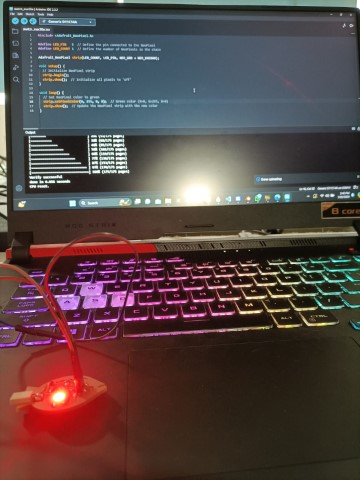Output Devices Week
For the reminder, I explored Neopixel and speaker so that I can use it in the reminder band.
Neopixel as an Output device
NeoPixels are special LEDs - they're not just one light but three! Each NeoPixel contains tiny red, green, and blue lights all in one package.
To light up the Neopixel
#include < Adafruit_NeoPixel.h>
#define LED_PIN 5 // Define the pin connected to the NeoPixel
#define LED_COUNT 1 // Define the number of NeoPixels in the chain
Adafruit_NeoPixel strip(LED_COUNT, LED_PIN, NEO_GRB + NEO_KHZ800);
void setup() {
// Initialize NeoPixel strip
strip.begin();
strip.show(); // Initialize all pixels to 'off'
}
void loop() {
// Set NeoPixel color to green
strip.setPixelColor(0, 0, 255, 0); // Green color (R=0, G=255, B=0)
strip.show(); // Update the NeoPixel strip with the new color
}



Changing this command, I got red colour. strip.setPixelColor(0, 255, 0, 0);
Changing this command again, I got blue colour. strip.setPixelColor(0, 0, 0, 255);
To colour cycle the neopixel
#include < Adafruit_NeoPixel.h>
#define LED_PIN 5 // Define the pin connected to the NeoPixel
#define LED_COUNT 1 // Define the number of NeoPixels in the chain
Adafruit_NeoPixel strip(LED_COUNT, LED_PIN, NEO_GRB + NEO_KHZ800);
void setup() {
// Initialize NeoPixel strip
strip.begin();
strip.show(); // Initialize all pixels to 'off'
}
void loop() {
colorCycle(10); // Speed of color cycling (adjust as needed)
}
// Function to cycle through colors
void colorCycle(uint8_t wait) {
uint16_t i;
for(i = 0; i < 256; i++) {
// Set NeoPixel color
strip.setPixelColor(0, Wheel((i) & 255));
strip.show();
delay(wait); // Wait between colors
}
}
// Input a value 0 to 255 to get a color value
// The colors are a transition r - g - b - back to r
uint32_t Wheel(byte WheelPos) {
if(WheelPos < 85) {
return strip.Color(WheelPos * 3, 255 - WheelPos * 3, 0);
} else if(WheelPos < 170) {
WheelPos -= 85;
return strip.Color(255 - WheelPos * 3, 0, WheelPos * 3);
} else {
WheelPos -= 170;
return strip.Color(0, WheelPos * 3, 255 - WheelPos * 3);
}
}
Speaker as an output device
Since I was planning to use a speaker ,it is required to use a trasistor. I used MOSFET (Metal-Oxide-Semiconductor Field-Effect Transistor). It is a type of transistor commonly used in electronic circuits for switching and amplifying electronic signals. When using a MOSFET with a speaker, it's typically employed as a switch to control the flow of current through the speaker.
This code of Happy birthday is from Alfia's documentation. The link is here.
#define led 2 // led pin
#define speakerPin 5
int length = 28; // the number of notes
char notes[] = "GGAGcB GGAGdc GGxecBA yyecdc";
int beats[] = { 2, 2, 8, 8, 8, 16, 1, 2, 2, 8, 8, 8, 16, 1, 2, 2, 8, 8, 8, 8, 16, 1, 2, 2, 8, 8, 8, 16 };
int tempo = 150;
void playTone(int tone, int duration) {
for (long i = 0; i < duration * 1000L; i += tone * 2) {
digitalWrite(speakerPin, HIGH);
delayMicroseconds(tone);
digitalWrite(speakerPin, LOW);
delayMicroseconds(tone);
}
}
void playNote(char note, int duration) {
char names[] = { 'C', 'D', 'E', 'F', 'G', 'A', 'B', 'c', 'd', 'e', 'f', 'g', 'a', 'b', 'x', 'y' };
int tones[] = { 1915, 1700, 1519, 1432, 1275, 1136, 1014, 956, 834, 765, 593, 468, 346, 224, 655, 715 };
int SPEE = 5; // play the tone corresponding to the note name
for (int i = 0; i < 17; i++) {
if (names[i] == note) {
int newduration = duration / SPEE;
playTone(tones[i], newduration);
}
}
}
void setup() {
pinMode(speakerPin, OUTPUT); //buzzer
pinMode(led, OUTPUT);
digitalWrite(led, HIGH);
delay(1000);
digitalWrite(led, LOW);
}
void loop() {
for (int i = 0; i < length; i++) {
if (notes[i] == ' ') {
delay(beats[i] * tempo); // rest
} else {
playNote(notes[i], beats[i] * tempo);
}
// pause between notes
delay(tempo);
}
delay(100);
}
